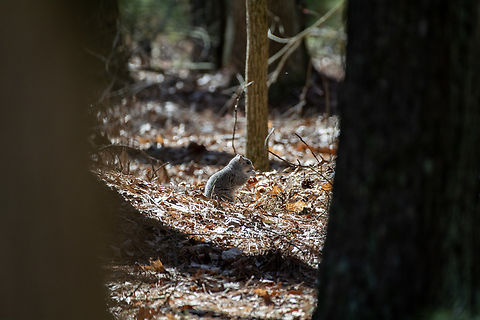
Status
The Delmarva fox squirrel was listed as an endangered species by the U.S. Fish and Wildlife Service in 1967. A recovery plan was developed in 1979 and revised in 1983 and 1993. A principal strategy for species recovery is protection of its habitat.The Delmarva fox squirrel was listed as an endangered species in 1967 because only 10% of its historical population was remaining. The cause of their significant decline in individuals was due to overhunting and habitat loss or destruction. Habitat destruction has been influenced by timber harvesting and farm land production. Housing developments, roads and increased commercial property are some other major factors for the continued loss of habitat. Along with human-induced causes, predation plays a large role in the decline of numbers. Red and gray foxes, weasels, mink, eagles and other animals are the cause of high predation rates as the Delmarva fox squirrel's habitat is within their range.
Many efforts have been made to restore habitat and increase the number of Delmarva fox squirrels within their historical range.
In 1979, the first recovery plan was developed to protect the habitat and increase the population of the Delmarva fox squirrel. In completing this plan, the biologists projected that the habitat would become more suitable to the lifestyle of the squirrels as well as other animals that share the same habitat. The plan consisted of 11 sites in Maryland that attempted to reintroduce between 8 and 42 individuals within a 1–3 year process. At each site the same number of males and females were released to assess the reproduction rates and survivability of each sex. Many tests were done after reintroduction by live trapping and recruitment within 9 of the overall 11 sites.
In a more recent conservation effort, many private and publicly owned lands were used to serve as habitat restoration areas. Private lands within the Delmarva fox squirrel range constitute for ~87% of the entire historical range of the DFS, while only 13% is of public land. A relationship between both public and private land owners allowed habitat restoration to occur in the 1990s. Different techniques were used by the Chesapeake Bay/Susquehanna River Ecoteam on public lands to monitor and reintroduce the Delmarva fox squirrel. Many private land owners also contributed to the restoration process by allowing biologists to access their land.
Within the recovery plan made in the late 1970s, the idea of translocations was a prominent tool used to increase the population of the Delmarva fox squirrel. The most recent effort allowed for trapping and relocation of the Delmarva fox squirrel to different habitats that would allow them to survive. The major goals were to reduce the probability of extinction, restore ecological diversity, and broaden the involvement of many areas in conservation effort. Eighty-three squirrels were used in this effort and they were all radio-collared for post-release tracking. The radio collars let biologists study the range and movements of the squirrels and tracked the distance traveled within a certain time period.
The Delmarva fox squirrel conservation effort has been an increasing success. The population within the historical range has increased and the many efforts have allowed for the habitats to become better suited for the Delmarva fox squirrel. Many issues have threatened the Delmarva fox squirrel with extinction, but continued work to restore habitat must be done in order for this species to have a sustainable population and for the Delmarva fox squirrel to remain off the Endangered Species List.
References:
Some text fragments are auto parsed from Wikipedia.